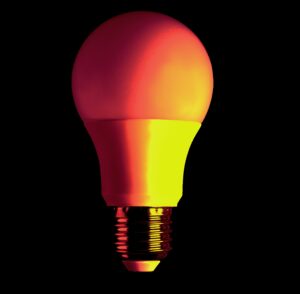LEDs & Heat: What You Need To Know
Posted by Emma Reid on 14th Dec 2021

LEDs are said to generate a lot less heat when compared to other kinds of light. Is this true? We’re taking a look at everything you need to know about LEDs and heat!
Firstly, it’s important to understand that LED bulbs will always produce some heat. This is just a natural result of any electrical device using power. That’s why plug sockets get warm!
The idea that LEDs generate absolutely zero heat is a myth, but they’re still a massive improvement on older bulbs. Incandescent bulbs show the most extreme difference. They only use 5% of the watts they receive to produce lumens, the other 95% is wasted on heat!
How much heat an LED bulb wastes depends largely on the quality of the bulb. Generally, an LED bulb will only use about 10% of their energy producing heat!
A good rule of thumb is that the hottest outside surface temperature of an LED bulb will be half the temperature of a halogen or incandescent bulb of equivalent brightness. They also tend to be about 20% cooler than CFLs.
How Do LEDs Stay Cool?
When they first came on the market, LEDs were a little notorious for getting overly hot. Since they’re electrical devices that are typically on for long periods of time, and they were made of materials that tend to trap heat, they could get hot despite not producing as much heat.
Nowadays, quality LEDs feature various cooling methods, such as integrated heat sinks. This ensures that any heat the bulb generates is safely dealt with, moving the heat away from the important parts of the bulb.
Older LEDs featured their heat sinks externally, but modern designs keep them internal.
Can I Touch An LED Bulb?
Everyone knows not to touch an older light bulb after it’s been on for a while. When a bulb blows, you should always wait a bit before swapping it out, or risk being burned and you should never touch a halogen or incandescent bulb while it’s still on.
LED bulbs will still get warm. However, they are typically safe to handle, especially around the neck area. This makes LED bulbs a great choice in fittings where there’s a chance someone could touch the lamp on accident, or in fittings used in children’s rooms where safety is a top priority.
If you’re using an older LED that features an external heat sink, make sure you do not touch this!
Integrated Or Retrofit?
The size of your bulb can have an impact on how hot your bulb gets, and that’s because larger bulbs have more room for heat sinks and other cooling solutions. An E27 bulb will often be very cool. Smaller bulbs, such as G9s, can get quite warm because there’s less space to work with.
Integrated LEDs, by contrast, are very good at dealing with heat even if they’re quite compact. That’s because they’re designed from inception to use LEDs, and they’re integrated into an all-in-one unit with the rest of the light. This allows for better implemented cooling methods.
You do lose the convenience of being able to swap out your bulb whenever you like, but integrated LEDs tend to last longer, and can get away with being smaller without producing lots of heat.
Looking After Your LED Bulbs
Despite the fact that they run much cooler, LEDs can be a little sensitive to heat. If the light emitting diodes get too hot, then this can really hamper their lifespan and cause them to burn out when they shouldn’t. Using the right bulbs in the right fitting will end this risk.
If you’re installing your bulb in an enclosed fitting (downlights are the most common example of this) you should make sure that they’re designed for this purpose. Likewise, you should make sure you’re using the right shape of bulb for your fitting, and are not using one that’s too large. This will help the bulb keep cool.
By understanding how heat and LEDs interact, you can maximise the lifespan and safety of your lights! If you have any more questions, get in touch by calling us on 0116 321 4120 or sending an email to cs@wled.co.uk. You can also follow us on YouTube, Twitter, Instagram or Facebook.





